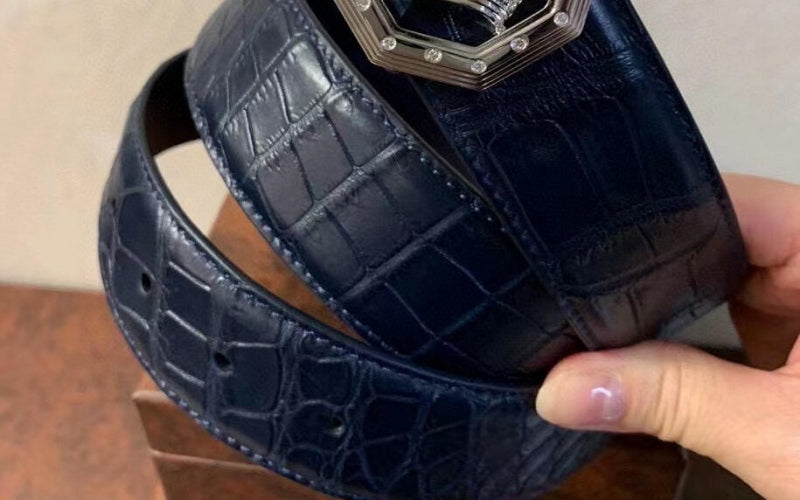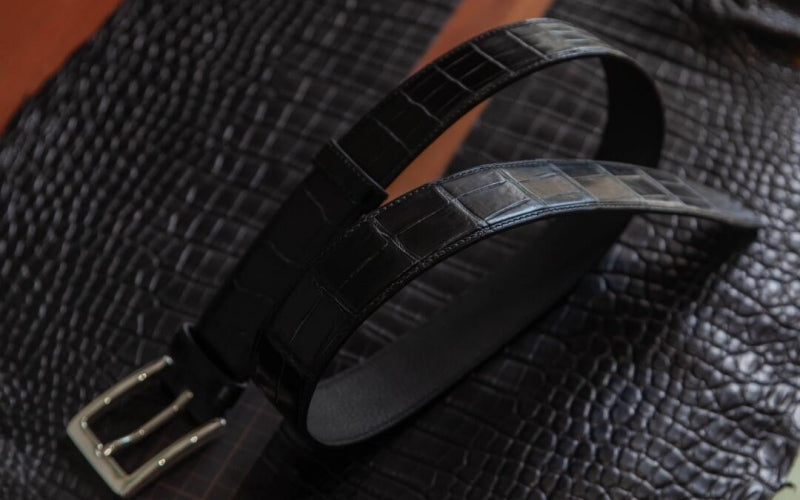
Is Crocodile Leather Better Than Alligator Leather?
Let’s settle this once and for all: Crocodile vs. alligator leather isn’t just a fashion debate—it’s a full-blown reptilian showdown. Imagine Godzilla vs. King Kong, but with more Instagrammable accessories. You’ve got two apex predators, both turned into luxury belts, both costing more than a used car. But which one reigns supreme?
As someone who’s held a baby croc in Australia and gotten lost in a Louisiana swamp chasing gators (don’t ask), I’m here to break down the scaly specifics.
We’ll dissect texture, ethics, price tags, and why your choice says more about you than your Spotify Wrapped.
 Interested with this belt? Please Click the picture above to see our collection.
Interested with this belt? Please Click the picture above to see our collection.
1. The Biology Beef: Crocs vs. Gators 101
Crocodiles:
-
Snout: V-shaped, like a toothy torpedo.
-
Teeth: Fourth tooth on the lower jaw sticks out when closed (they’re the meth heads of reptiles).
-
Habitat: Saltwater champs. Found in Australia, Africa, and your nightmares.
Alligators:
-
Snout: U-shaped, like a shovel with anger issues.
-
Teeth: All teeth hidden when closed (they’re the passive-aggressive cousins).
-
Habitat: Freshwater loungers. Mostly in the U.S. and China.
Why It Matters: Croc skin has larger, more irregular scales; gator skin is smoother and symmetrical. Translation: Crocs are the edgy rockstars, gators are the prep school valedictorians.
 Interested with this belt? Please Click the picture above to see our collection.
Interested with this belt? Please Click the picture above to see our collection.
2. Texture & Aesthetics: The Feel-Good Factor
Crocodile Leather:
-
Scale Pattern: Large, jagged osteoderms (those bumpy scales) with a 3D effect. The belly scales are prized for their symmetry.
-
Feel: Stiffer, more textured—like running your hand over a dragon’s back.
-
Luxury Clout: Hermès’ Birkin bags use porosus croc for its “holy grail” status.
Alligator Leather:
-
Scale Pattern: Smaller, uniform scales. The belly leather is softer and pebbled.
-
Feel: Softer, supple—like butter that’s been to finishing school.
-
Luxury Clout: Louis Vuitton’s Taiga leather line favors gator for its understated vibe.
Fun Fact: Croc belly leather is 30% more expensive than gator due to its rarity. Want a belt that looks like it fought a knight? Go croc.
 Interested with this belt? Please Click the picture above to see our collection.
Interested with this belt? Please Click the picture above to see our collection.
3. Durability: Which Survives a Bar Fight?
Crocodile:
-
Pros: Thicker skin with denser scales = survives scuffs, spills, and existential crises.
-
Cons: Stiffness can lead to cracking if not conditioned (think of it as reptile Botox).
Alligator:
-
Pros: More flexible, molds to your body like a clingy ex.
-
Cons: Softer scales scratch easier. Drop your keys? Say goodbye to perfection.
Real Talk: A croc belt will outlive your marriage. A gator belt? Maybe your gym membership.
 Interested with this belt? Please Click the picture above to see our collection.
Interested with this belt? Please Click the picture above to see our collection.
The Price Tag: Why Your Wallet’s Screaming
Crocodile:
-
Cost: $2,500–$10,000+ for a belt. Porosus croc (saltwater) is the priciest—it’s the Rolex of reptiles.
-
Why?: Fewer farms, wilder habitats, and that #BirkinHaloEffect.
Alligator:
-
Cost: $1,200–$5,000. American gator is cheaper thanks to Louisiana’s farming empire.
-
Why?: Higher supply, easier farming (gators are basically swamp couch potatoes).
Beltley’s Hot Take: Our full-grain cowhide belts cost 1/10th the price and still look fire. But hey, we get it—sometimes you need to flex.
 Interested with this belt? Please Click the picture above to see our collection.
Interested with this belt? Please Click the picture above to see our collection.
The Ethical Swamp: Which Is Less Evil?
Crocodile Farming:
-
Common in: Australia, Southeast Asia.
-
Controversies: Crocs are solitary in the wild but packed into pens. PETA raids are frequent.
-
CITES Status: Saltwater crocs (porosus) are Appendix I (endangered) in some regions.
Alligator Farming:
-
Common in: Louisiana, Florida.
-
Controversies: More regulated, but habitat destruction for farms is an issue.
-
CITES Status: American gators are Appendix II (controlled trade).
Verdict: Gator farming is “less bad”… but you’re still wearing a dead predator.
 Interested with this belt? Please Click the picture above to see our collection.
Interested with this belt? Please Click the picture above to see our collection.
Maintenance: High-Maintenance vs. Chill
Crocodile:
-
Conditioning: Every 4–6 weeks with reptile-specific balm. Skip a session, and cracks appear faster than wrinkles on a TikTok filter.
-
Storage: Lay flat in a climate-controlled room (kidding… but not really).
Alligator:
-
Conditioning: Every 2–3 months. More forgiving, like that friend who doesn’t judge your messy bun.
-
Storage: A dust bag works… unless your cat thinks it’s a toy.
Pro Tip: Buy a CITES-certified cleaning kit or risk voiding your “luxury” warranty.
 Interested with this belt? Please Click the picture above to see our collection.
Interested with this belt? Please Click the picture above to see our collection.
Celebrity Endorsements: Who Wears What
-
Crocodile Crew: Jay-Z (of course), Kim Kardashian (gold-plated everything), and Jeff Bezos (because space wasn’t enough).
-
Alligator Squad: Barack Obama (subtle power), Meghan Markle (quiet luxury), and Elon Musk (to distract from Twitter chaos).
Takeaway: Croc = flashy new money. Gator = old-money stealth.
Resale Value: Which Funds Your Midlife Crisis?
Crocodile:
-
Value Retention: 60–70% if pristine. A vintage Hermès croc belt can appreciate like fine art.
-
Market: Global demand, especially in Asia and the Middle East.
Alligator:
-
Value Retention: 40–50%. Less “wow” factor, but still a solid investment.
-
Market: Strong in the U.S. and Europe, but fading with Gen Z’s vegan wave.
Beltley’s Plug: Our belts won’t fund your retirement, but they also won’t tank your karma.
The Vegan Factor: Can Alternatives Compete?
Lab-Grown Croc/Gator:
-
Pros: Same look, no death. Brands like VitroLabs are 3D-printing “skin” from cells.
-
Cons: Costs $3,000+, and good luck explaining it at a dinner party.
Plant-Based Alternatives:
-
Cactus Leather: Durable, sustainable, and $300–$500.
-
Mushroom Leather: Yes, it’s a thing. No, it won’t get you high.
The Final Showdown: Which Should You Buy?
Choose Crocodile If:
-
You want maximum flex and don’t mind side-eye from vegans.
-
You’re okay with babying your belt like a Tamagotchi.
-
Your style icon is Tony Stark in a safari hat.
Choose Alligator If:
-
You prefer understated luxury (aka rich people incognito mode).
-
You live in humid climates (gator leather handles moisture better).
-
You want to impress your dad, not your TikTok followers.
Choose Beltley’s Cowhide If:
-
You’d rather save $2,000 and still look sharp.
-
You think “exotic” should describe vacations, not your belt.
11. The Legal Lowdown: Can You Even Own This Stuff?
-
California: Bans all croc/gator products. Yes, even that vintage eBay find.
-
EU: Requires CITES paperwork for imports. Lose it, and customs will roast you.
-
Australia: Exporting croc leather? Get ready for a 50-page permit.
Pro Tip: If you’re in a banned state, just say it’s embossed cowhide. They’ll never know.
12. The Last Word: Are You a Croc or a Gator?
At the end of the day, choosing between croc and gator leather is like choosing between a Lamborghini and a Bentley—both scream “I’m rich,” but one’s louder.
If you’ve got the cash, the conscience, and a climate-controlled closet, go wild. If not? There’s no shame in rocking a Beltley classic and donating the extra $5k to save real alligators.
Still debating? Peep our Ultimate Leather Guide or drop a comment. Confession time: Have you ever splurged on something ridiculous? Spill below—we’ve all been there.

